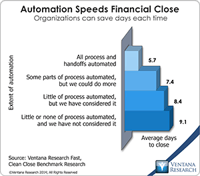A lot of conversations around contact centers deal with automation, particularly how to balance the way humans and automated systems work together. Self-service, the front end of the customer interaction, is where practitioners get a first taste of the marvels of increasingly advanced automation. As customer expectations ramped up and labor became more costly during the pandemic, deflecting interactions away from agents took on new urgency. We continue to see impressive advances in automated...
Read More
Topics:
Customer Experience,
Self-service,
automation,
Contact Center,
Knowledge Management,
agent management,
Customer Experience Management,
Intelligent Self-Service,
Conversational AI
Reconciling accounts at the end of a period is one of those mundane finance department tasks that are ripe for automation. Reconciliation is the process of comparing account data (at the balance or item level) that exists either in two accounting systems or in an accounting system and somewhere else (such as in a spreadsheet or on paper). The purpose of the reconciling process is to identify things that do not match (as they must in double-entry bookkeeping systems) and then assess the nature...
Read More
Topics:
Office of Finance,
automation,
Reconciliation
I recently attended BlackLine’s annual user conference. The company aims to automate time-consuming repetitive tasks and substantially reduce the amount of detail that individuals must handle in the department. The phrase “the devil is in the details” certainly applies to accounting, especially managing the details in the close-to-report phase of the accounting cycle, which is where BlackLine plays its role. This phase spans from all the pre-close activities to the publication of the financial...
Read More
Topics:
automation,
close,
closing,
Consolidation,
control,
effectiveness,
Reconciliation,
CFO,
compliance,
Data,
controller,
Financial Performance Management,
FPM,
Sarbanes Oxley,
Accounting,
process management,
report
Robotic process automation (RPA) relies on programming or the application of analytical algorithms to execute the most appropriate action in an automated workflow. RPA enables business users to configure a “robot” (actually, computer software) to interact with applications or data sources to process a transaction, move or manipulate data, communicate with other digital systems and manage machine-to-machine and man-to-machine interactions. This technology is gaining increasing notice by finance...
Read More
Topics:
Operations,
automation,
close,
closing,
Continuous Accounting,
finance,
banking,
Robotic Process Automation,
Accounting
Reconciling accounts at the end of a period is one of those mundane finance department tasks that are ripe for automation. Reconciliation is the process of comparing account data (at the balance or item level) that exists either in two accounting systems or in an accounting system and somewhere else (such as in a spreadsheet or on paper). The purpose of the reconciling process is to identify things that don’t match (as they must in double-entry bookkeeping systems) and then assess the nature...
Read More
Topics:
Office of Finance,
automation,
close,
closing,
Consolidation,
Controller,
effectiveness,
Reconciliation,
XBRL,
Business Performance,
Financial Performance,
Governance, Risk & Compliance (GRC),
CFO,
Data,
Document Management,
Financial Performance Management,
FPM













